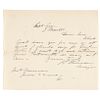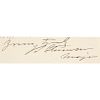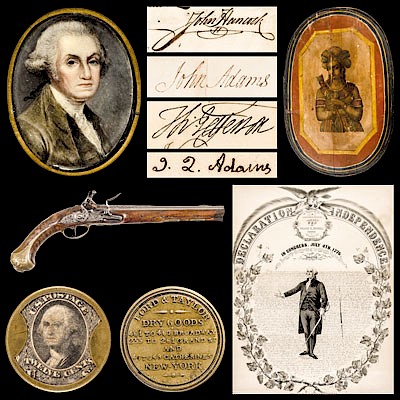1865 Lincoln Assassination Period Letter to the Quartermaster at Fortress Monroe
Lot 263
Estimate:
$600 - $900
Absentee vs Live bid
Two ways to bid:
- Leave a max absentee bid and the platform will bid on your behalf up to your maximum bid during the live auction.
- Bid live during the auction and your bids will be submitted real-time to the auctioneer.
Bid Increments
| Price | Bid Increment |
|---|---|
| $0 | $10 |
| $200 | $20 |
| $300 | $25 |
| $500 | $50 |
| $1,000 | $100 |
| $2,000 | $200 |
| $3,000 | $250 |
| $5,000 | $500 |
| $10,000 | $1,000 |
| $20,000 | $2,000 |
| $30,000 | $2,500 |
| $50,000 | $5,000 |
| $100,000 | $10,000 |
| $200,000 | $20,000 |
| $300,000 | $25,000 |
| $500,000 | $50,000 |
About Auction
By Early American History Auctions
Jun 1, 2019
Set Reminder
2019-06-01 12:00:00
2019-06-01 12:00:00
America/New_York
Bidsquare
Bidsquare : Historic Autographs, Colonial Currency, Political Americana & Revolutionary War Era
https://www.bidsquare.com/auctions/early-american-history-auctions/historic-autographs-colonial-currency-political-americana-revolutionary-war-era-4152
Historic Autographs, Coins, Currency, Political, Americana, Historic Weaponry and Guns, John Adams, Thomas Jefferson, Early American History Auctions auctions@earlyamerican.com
Historic Autographs, Coins, Currency, Political, Americana, Historic Weaponry and Guns, John Adams, Thomas Jefferson, Early American History Auctions auctions@earlyamerican.com
- Lot Description
Abraham Lincoln Related
June 22, 1865 Letter Related to the Abraham Lincoln Assassination Military Commission Trial of the Conspirators
June 22, 1865-Dated, Abraham Lincoln Assassination & Trial Period, Manuscript Letter to the Quartermaster at Fortress Monroe, Virginia, regarding "Quick Passage," Choice Extremely Fine.
This original Manuscript Letter is 1 page, measuring 6.5" x 7.75" and is very well written in dark brown ink on quality wove period paper. It is extremely clean having nice eye appeal, embossed "North River" into the paper at the upper left corner, on centerfold, blindstamped June 22, 1865 - Fort Monroe, VA on the reverse and docket by "J.S. Stevenson - June 22-65" on its blank reverse. It was sent to the Quartermaster at Fortress Monroe, Virginia, by Major J.S. Stevenson, who was an Aide to Brevet Major General Robert Foster. Here he is seeking quick passage to Portsmouth (Virginia), as soon as possible. General Foster at this time was a Member of the Military Commission that was in the process of trying the Conspirators in the Lincoln Assassination
This Letter is dated on June 22, 1865, just a few days before the Commission would render its verdicts. It is a reasonable assumption that the haste shown in this Letter may very possibly be related to the case of Mrs. Mary Surratt, whom many members of the Commission were reluctant to condemn, because of her being a woman. Further research may well prove this important historic assumption, having the likely possibility to be correct. If so, being related to the trial and use of the federal death penalty in American history, being for the first time actually used in the case of a woman, Mary Surratt, who was indeed hung.
In the turmoil that followed the assassination, scores of suspected accomplices were arrested and thrown into prison. All the people who were discovered to have had anything to do with the assassination or anyone with the slightest contact with Booth or Herold on their flight were put behind bars.
Among the imprisoned were Louis J. Weichmann, a boarder in Mrs. Surratt's house; Booth's brother Junius (playing in Cincinnati at the time of the assassination); theatre owner John T. Ford, who was incarcerated for 40 days; James Pumphrey, the Washington livery stable owner from whom Booth hired his horse; John M. Lloyd, the innkeeper who rented Mrs. Surratt's Maryland tavern and gave Booth and Herold carbines, rope, and whiskey the night of April 14; and Samuel Cox and Thomas A. Jones, who helped Booth and Herold escape across the Potomac.
All of those listed above and more were rounded up, imprisoned, and released. Ultimately, the suspects were narrowed down to just eight prisoners (seven men and one woman): Samuel Arnold, George Atzerodt, David Herold, Samuel Mudd, Michael O'Laughlen, Lewis Powell, Edmund Spangler (a Ford's stagehand who had given Booth's horse to "Peanuts" Burroughs to hold), and Mary Surratt.
The eight suspects were tried by a military tribunal ordered by now-President Andrew Johnson on May 1, 1865. The nine member commission was presided over by Major General David Hunter. The other eight voting members were August Kautz, Albion P. Howe, James A. Ekin, David Clendenin, Lew Wallace, Robert Foster, Thomas M. Harris and Charles H. Tompkins. The prosecution team included Judge Advocate General Joseph Holt, John A. Bingham, and H.L. Burnett. The transcript of the trial was recorded by Benn Pitman and several assistants, and was published in 1865. The fact that they were tried by a military tribunal provoked criticism from both Edward Bates and Gideon Welles, who believed that a civil court should have presided. Attorney General James Speed, on the other hand, justified the use of a military tribunal on grounds that included the military nature of the conspiracy and the existence of martial law in the District of Columbia. (In 1866, in the Ex parte Milligan decision, the United States Supreme Court banned the use of military tribunals in places where civil courts were operational.) The odds were further stacked against the defendants by rules that required only a simple majority of the officer jury for a guilty verdict and a two-thirds majority for a death sentence. Nor could the defendants appeal to anyone other than President Johnson.
The trial lasted for about seven weeks, with 366 witnesses testifying. Louis Weichmann, released from custody, was a key witness. All of the defendants were found guilty on June 30. Mary Surratt, Lewis Powell, David Herold, and George Atzerodt were sentenced to death by hanging; Samuel Mudd, Samuel Arnold, and Michael O'Laughlen were sentenced to life in prison. Mudd escaped execution by a single vote, the tribunal having voted 5-4 to hang him. Edmund Spangler was sentenced to imprisonment for six years. Oddly, after sentencing Mary Surratt to hang, five of the jurors signed a letter recommending clemency, but Johnson refused to stop the execution. (Johnson later claimed he never saw the letter.)
Surratt, Powell, Herold, and Atzerodt were hanged in the Old Arsenal Penitentiary on July 7, 1865. Mary Surratt was the first woman hanged by the U.S. government. O'Laughlen died in prison of yellow fever in 1867. Mudd, Arnold, and Spangler were pardoned in February 1869 by President Johnson. Spangler, who died in 1875, insisted for the rest of his life that he had no connection to the plot beyond being the man Booth asked to hold his horse.
- Shipping Info
-
Early American provides in-house worldwide shipping. Please contact us directly if you have questions about your specific shipping requirements.
-
- Buyer's Premium



 EUR
EUR CAD
CAD AUD
AUD GBP
GBP MXN
MXN HKD
HKD CNY
CNY MYR
MYR SEK
SEK SGD
SGD CHF
CHF THB
THB













